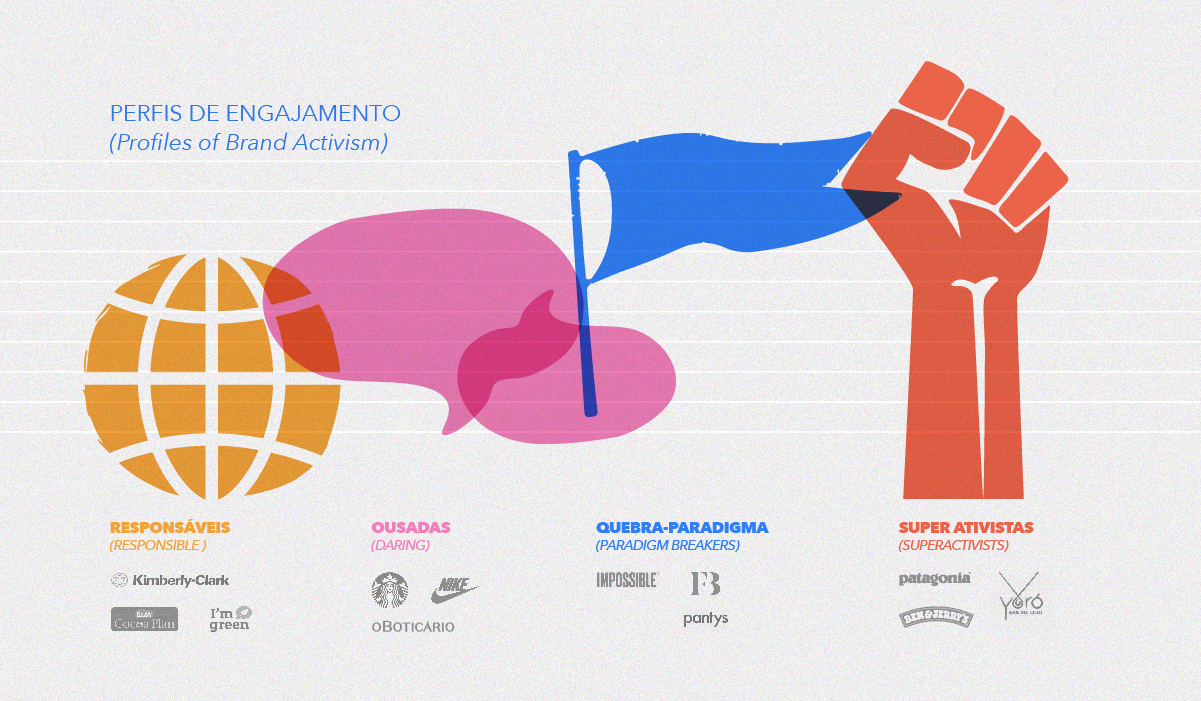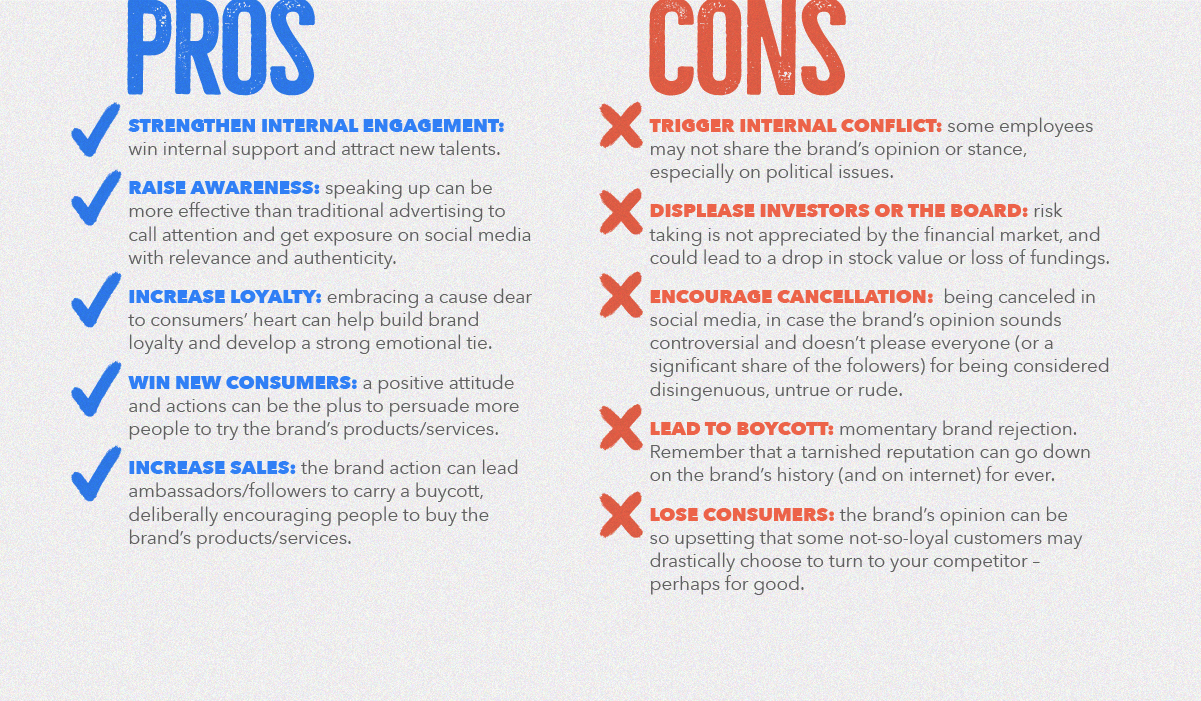
Brand activism is nothing new. The importance of having a clear purpose has been extensely discussed for decades. Aligned with this foremost intention comes the necessity to define which causes a brand wants to support, meeting the demands of an audience that craves for more humane and coherent stances. Nowadays, brands have to stand for more than just profit: they are expected to contribute to building a better society.
The uncontrolled pandemic, the polarization of society, the stronger presence of social media and the growing cancel culture have boosted the game. What used to be an opportunity, is now a requirement – at times, essential for the survival. Brands have to build a positive impact territory; the mere position of trading goods and services, coupled with the neutrality towards relevant issues such as racism, gender, feminism and environment, is no longer a strong enough offer. Not taking a stand may give rise to the impression of consent, while stating an opinion can be seen as hypocrisy – if the talk is not followed by concrete actions, aligned with the brand’s DNA – depleting the brand’s value.
Thus, brands must take a clear stance and genuinely commit to one or more causes to remain competitive. The challenge faced is how to approach it constructively, being faithful to the brand’s values and not sounding self-serving, besides being careful to minimize the risks of boycott in an increasingly demanding environment where one slip can be fatal.
Bearing this challenging and intriguing setting in mind, we propose some reflections to help brands understand the different possible types and levels of activism, the risks and benefits of speaking up. Paths that, when followed with truth and transparency, can lead to a real and long-lasting commitment.
Different types and profiles of brand activism
We all know, there is no single way to engage, and there is no right or wrong. We suggest below an ‘activism profile classification’ based on the brand’s DNA and its intended relation with its stakeholders, more than on the company’s size or category. Here they are:

Superactivists
Brands that are activists since foundation, deeply engaged with causes related to the brand’s core values, and supported by the founding partners or CEOs themselves. They believe that action speaks louder than words, and they take to the streets with its public to be heard and actually aim to achieve social change. They create a strong emotional tie with its fans, so much that they usually become brand ambassadors.
- The most known and successful example may be Patagonia, the outdoor lifestyle brand commited to environmental causes, whose ad “don’t buy this jacket” – encouraging people to reconsider impulse purchases – became a talking point.
- Ice-cream brand Ben & Jerry’s (Unilever) is also resolutely committed to social causes.
- In Latin America, the Colombian water brand Yoró – Água del Cielo was created to help the village of Lloró – from the needy department of Chocó – promising to pay back 50% of its net profit to the city. The brand’s founder, José F. Ramirez, explains that “from the beginning, the objective was to build a brand that makes a positive environmental and social impact. We were born with this mission, which guides our storytelling and storymaking. More than a one-time action or single donation, the project was created to be sustainable over time and to have a long-term effect”.
Paradigm-breakers
Innovative brands, pioneers in their respective businesses since foundation. Their own core products or services are their flags, since their proposal is to change patterns and break a category status quo. They usually forge an emotional bond with their consumer base, for meeting previously unmet needs.
- Impossible Burger and Fazenda Futuro are examples of this profile. Pioneers in the plant-based meat industry, their mission is to reduce the negative environmental impact of beef slaughtering.
- Another example is Rihanna’s Fenty Beauty makeup brand, which has launched 50 shades of foundation in a still exclusive market.
- In Brazil the brand of period panties – Pantys – offers an eco-responsible menstrual solution.
- Starbucks, in the United States, has waded into social justice issues, raising positive feedback, but also criticism. The brand forbid guns in its stores after a mass shooting, supported gay marriage and encouraged discussion on racism (this last causing backlash).
- Nike caused huge uproar for partnering with the American civil rights activist and football quarterback Colin Kaepernick, and for the ad “Just don’t do it”, asking people not to turn their backs to the existing racism. The brand, which already has many commitments to fight racism, received much praise, but was also anticipating loss of support from more conservative Americans – which happened indeed.
- In Brazil, Boticário promotes racial equity, picturing black families in the communication material for Christmas and fathers’ day, backed by concrete initiatives.
- Here, three giants are worth mentioning: Nestlé, with the Cocoa Plan, that guarantees fair trade cocoa production, offering decent working conditions to the farmers’ families; Kimberly-Clark, with its ambitious goal to reduce the carbon footprint of its operations by 50% by 2030 and Braskem, with the I’m green™ brand, that reinforces the company commitment to Circular Economy.
Advantages & disadvantages of brand activism
So, when is it worth to engage and get political about a current cause or issue? For Carolina Barruffini, CBA B+G Branding director, brands have to be more daring: “No doubt there are some risks involved when brands engage in relevant causes. However, many real examples have showed us that taking action is better than not taking a stand, even if there’s little impact – provided that the action is driven by truth and transparency.”
We listed below the pros and cons that every brand must consider before taking a stand.

Best practices for positive, real and lasting impact
How then, can brand activism be a long-term, authentic and minimal-risk commitment? We suggest 8 steps to make it happen. It is a long journey, however it can surely put you on the right track to remain relevant in the future.
The 8 steps for achieving Positive Impact are:
1. Define a clear and powerful brand positioning
What is the brand reason for being, its beliefs? What is the brand’s DNA, its personality, its target audience? Branding for the future – a playbook with thoughts on how to reconnect brands, consumer and market – the three fundamental business spheres (which are still more importante in times of pandemic) – is a way to help you understand the brand context and its actions. Learn more about it here.
2. Choose your battles
Based on the brand core values – and aligned with them –identify the causes that the brand has credibility to support.
3. Define the stakeholders
Besides the target audience and brand consumers, who else does the brand impact, directly or indirectly, externally or internally? Stakeholders include employees and their family, board and investors, influencers, specialized media, government and social agents.
4. Look at the brand’s track record (and its present moment)
Although the brand purpose may have evolved over the years, the brand’s past cannot be ignored. It’s important to revisit previous actions, statements and campaigns to assess the credibility of engaging on a topic. And, sometimes, make a mea culpa (Skol has done this in 2017, who remembers?). Also, reputation must be considered; if it is fragile, spotlighting your brand may not be the best move.
5. Define the brand activism profile
Among the different profiles – superactivist, paradigm breaker, daring, responsible – which makes more sense for your brand today and which it aspires for the future?
6. Identify potential risks
The more renowned the brand is, the more important it is to assess the risks and benefits of taking a stance – or of staying neutral.
7. Walk the talk
Promises, great speeches or fierce campaigns are not enough to guarantee a brand’s survival without significant and real actions to support them. Consumers expect the brand (company) to engage in a realistic and tangible way, and if it doesn’t, they will ask for it.
8. Listen to feedback
Stakeholders feedback deserve attention. The brand must learn from its mistakes and successes and act quickly. Monitoring the brand’s “promises versus deliveries” can be decisive for the brand’s health and reputation.
Would you like to delve deeper into the topics of activism, brands and branding? We recommend: watching the interview with Rose Marcaria – Patagonia President and CEO – for Stanford students; listening to the episode Ativismo nos dias atuais (Today’s activism), from the podcast “O Tempo Virou” by Giovanna Nader, with the social activist Alessandra Orofino; and last but not least, reading this excellent article on the importance of taking risks, written by brand strategist Jasmine Bina.
You can always get in touch with us if you wanna chat about the challenges and opportunities for your brand. And if this subject inspires you and you are or know business professionals, strategists and designers who are interested in being part of our team, send an e-mail to [email protected] with expectations, goals and stories. We are always looking for new talents!
The content of this article had the contribution of: Carmen Beer, Ana Cerqueira, Giuliana Sanchez, Thaísa Miyahara, Carolina Barrufini, Ana Biselli, Renato Storni, José F. Ramirez, Fabiana Quiroga, Josy Lamenza, Daniela Irrazabal, and Luis Bartolomei.
